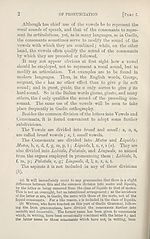Books and other items printed in Gaelic from 1871 to 1900 > Elements of Gaelic grammar
(21) [Page 1] - Part 1 -- Of pronunciation and orthography
Download files
Complete book:
Individual page:
Thumbnail gallery: Grid view | List view
![(21) [Page 1] - Part 1 -- Of pronunciation and orthography](https://deriv.nls.uk/dcn17/1065/5953/106559531.17.jpg)
ELEMENTS OE GAELIC GEMMAE.
PAET I.
OP PRONUNCIATION AND ORTHOGRAPHY.
The Gaelic alphabet consists of eighteen letters: a, b, c,
d, e, f, g, h, i, 1, m, n, o, p, r, s, t, u. Of these, five are
vowels, a, e, i, o, u ; the rest consonants.
In explaining the powers of the letters, and of their
several combinations, such obstacles lie in the way that
complete success is not to be expected. In order to explain,
in writing, the sounds of a particular language, the only
obvious method is to represent them by the letters com¬
monly employed to exhibit similar sounds in some well-
known living language. But there are sounds in the
Gaelic to which there are none perfectly similar in English,
nor perhaps in any modern European tongue. Besides, the
same combination of letters does not invariably represent the
same sound in one age that it did in a former, or that it
may do in the next. And this may be equally true of the
letters of the Gaelic alphabet, whose powers are to be taught;
and of the letters of any other language, by whose sounds
the powers of the former are to be explained. A diversity
of pronunciation is very distinguishable also in different dis¬
tricts of the Highlands of Scotland, even in uttering the
same words written in the same manner. Though the
powers of the letters, then, may be explained to a certain
degree of accuracy, yet much will still remain to be learned
by the information of the ear alone.
A
PAET I.
OP PRONUNCIATION AND ORTHOGRAPHY.
The Gaelic alphabet consists of eighteen letters: a, b, c,
d, e, f, g, h, i, 1, m, n, o, p, r, s, t, u. Of these, five are
vowels, a, e, i, o, u ; the rest consonants.
In explaining the powers of the letters, and of their
several combinations, such obstacles lie in the way that
complete success is not to be expected. In order to explain,
in writing, the sounds of a particular language, the only
obvious method is to represent them by the letters com¬
monly employed to exhibit similar sounds in some well-
known living language. But there are sounds in the
Gaelic to which there are none perfectly similar in English,
nor perhaps in any modern European tongue. Besides, the
same combination of letters does not invariably represent the
same sound in one age that it did in a former, or that it
may do in the next. And this may be equally true of the
letters of the Gaelic alphabet, whose powers are to be taught;
and of the letters of any other language, by whose sounds
the powers of the former are to be explained. A diversity
of pronunciation is very distinguishable also in different dis¬
tricts of the Highlands of Scotland, even in uttering the
same words written in the same manner. Though the
powers of the letters, then, may be explained to a certain
degree of accuracy, yet much will still remain to be learned
by the information of the ear alone.
A
Set display mode to:
![]() Universal Viewer |
Universal Viewer | ![]() Mirador |
Large image | Transcription
Mirador |
Large image | Transcription
Images and transcriptions on this page, including medium image downloads, may be used under the Creative Commons Attribution 4.0 International Licence unless otherwise stated. ![]()
| Rare items in Gaelic > Books and other items printed in Gaelic from 1871 to 1900 > Elements of Gaelic grammar > (21) [Page 1] - Part 1 -- Of pronunciation and orthography |
|---|
| Permanent URL | https://digital.nls.uk/106559529 |
|---|
| Description | Out-of-copyright books printed in Gaelic between 1631 and 1900. Also some pamphlets and chapbooks. Includes poetry and songs, religious books such as catechisms and hymns, and different editions of the Bible and the Psalms. Also includes the second book ever published in Gaelic in 1631. |
|---|

